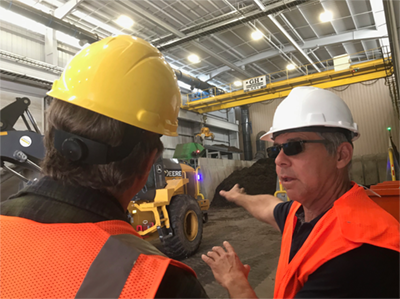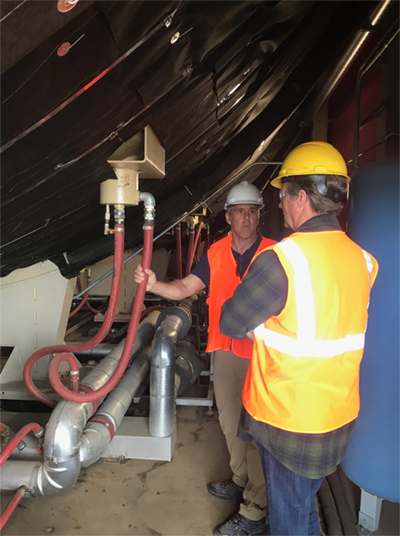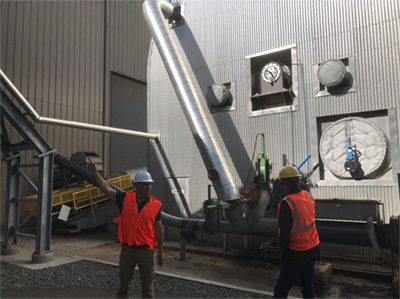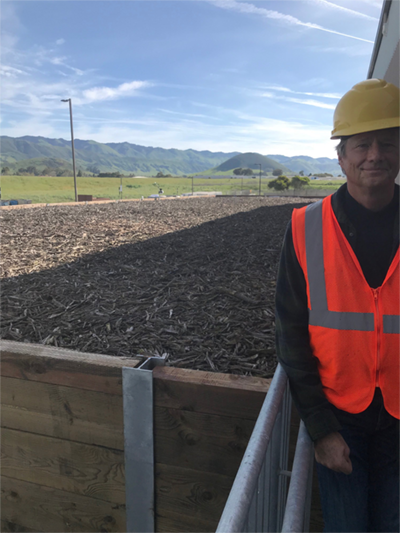The Digester
April 1, 2019

We were invited by our dear friend and neighbor, Noah Small, to visit the first Kompogas project in the United States! Noah is a farmer, entrepreneur and environmentalist. And because of his reputation in sustainable farming practices, he was approached by a collaborative that sought to replicate the industrial scale composting devices used for decades by Europeans. These are also known as dry anaerobic digestion plants
We donned our hard hats, protective eye gear and reflective vests, escorted by our dear friend onto the campus financed by Japan Bank for International Cooperation. This enterprise, was realized with the collaboration of Hitachi Zozena Inova, with members from Zurich, Osaka and the US. The first large building, similar to an airplane hangar, was much our mouth, Noah explained, the entry to our digestive system. There were large earth movers delivering the green waste to large “masticating” bins, which were conveyed far above our heads for further refinement.

The “boluses” were delivered outside, through enclosed conveyor belts to a 3 story high tank, measuring 150 feet in length. This was the digester! From the entry point, the waste products are gently pushed and stirred by a cork screw-like piston, which controls the transit of 14 days. The digester is encircled by insulated hoses which maintain a 131 degree F (55 Celsius) temperature within, to ensure the success of the ANAEROBIC process.
From the end, about 30% of the digested product is reintroduced into the digester’s entrance so as to sustain the inoculation of healthy microbes. (Think of the dough one saves in order to make the next batch of Sour dough bread.) Meanwhile, 70% of the product is pumped through another set of pipes and by gravitational/ centrifugal forces, a solute is collected to form a “compost tea.” Soon to be tested and certified as nutritive irrigant for crops! In keeping with Noah’s analogy, this clearly reminds us of the small intestines.

Above: The back or exit side of the Digester. Lower horizontal pipe delivers the compost tea to tank (not shown)
This system, by the way, produces much methane. This is simultaneously and ingeniously collected into tanks as an energy source to promote the self-sufficiency of this enterprise- as the Digester, ultimately, has a net ZERO carbon foot print. Incidentally, there are safety structures, much like smoke stacks, which are available to blow off unexpected high surges of the gas to prevent explosion. Like flatulence to prevent bowel rupture- you get it.

Which leads us to the final deposition of the compost product, into another large warehouse, with enough room inside to compartmentalize the compost as it is evacuated from overhead pipes, and to accommodate a couple of transport containers and the turning radius for a few dump trucks! Approximately 32,000 Tons of biowaste and green waste material can be transformed into 22,000 Tons of fantabulous high grade compost and liquid fertilizer per year! While also producing 2,900,000 Nm3 of bio-gas!
To mitigate the odor, several feet of almond wood chips create a natural filtration, which really works!
We hope to be among the first farmers in San Luis Obispo county to purchase both the compost and the tea to grow our olives and produce organic extra virgin olive oil. It will be an honor to be a part of this community (and national) environmental project!
Thanks, Noah!
